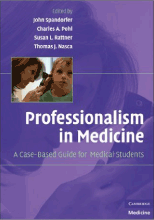
|
|
Spandorfer J, Pohl C, Nasca T, Rattner SL, eds. Professionalism in Medicine : A Case-Based Guide for Medical Students. Cambridge: Cambridge University Press; 2010.
|
| Thomas Jefferson University |
Video: Principle of Patient Welfare | Commentaries
A Faculty Perspective
The tension between service to patients and attention to personal concerns is pervasive in medicine and can be especially poignant for students because of the importance of meeting supervisors' expectations. Altruism, the commitment to put the interests of others before one's own, is a core value of medicine but making it a living value, that can be both aspired to and enacted daily, is challenging. This challenge has increased over the past generation as medicine has become substantially feminized, obviating the division of labor that allowed physician-fathers to devote themselves to their patients while stay-at-home mothers managed the household.
The third year medical student in the vignette is faced with a discrepancy between her understanding of the expectations for her post-call responsibilities and what she believes her resident requires. Her perceptions of her resident's standards for a third year student may be inaccurate, but perhaps not. Unfortunately, residents too commonly say, "Where I went to medical school, the students stayed all night with their teams" or "Students carried as many patients as the interns". Once the resident has even intimated such expectations it is difficult for a conscientious student to choose to fall short of them. And, while students overestimate the importance of "putting in the hours", the resident's opinion of her diligence and commitment to patients will certainly color her evaluation.
The impact of duty hour reduction (DHR), mandated for residents in 2003, has been complex and controversial. There are five outcomes of particular interest: the quality of patient care(1, 2); resident personal life and safety; fostering of altruism; accomplishment of work previously done by residents; and teaching and learning by all trainees(3-5). Although directed at housestaff, DHR has implications for medical students. Better-rested residents might be more willing to teach or, given the obligation to be out of the hospital within 30 hours of the beginning of a shift, residents may prioritize patient care over teaching. Faculty and students may feel that they are filling in for residents who are mandated to be out of the hospital. Predictably, the specific strategies used to reduce resident duty hours influence whether the impact is regarded as beneficial or deleterious(6).
Medical schools must ensure that student patient care responsibilities conform to school policy and that student learning is not compromised by policy changes intended to address other issues. Medical students already evaluate resident teaching and the learning opportunities afforded by their clerkships. Perhaps evaluations should contain additional items encouraging students to reflect on the balance between service to patients and their own personal needs and addressing the clerkship's conformance to school policy. The student might be asked to respond to items such as: "This clerkship supported my continued learning about altruism and balancing my service to patients with my other roles and responsibilities" and "The resident's expectations of my performance were consistent with school policy (night call, patient load, scut, etc)."
Medicine in the 21st century requires a "new professionalism"(7); there is more to devotion to patients than working to exhaustion.
References:
- Mountain SA, Quon BS, Dodek P, Sharpe R, Ayas NT. The impact of housestaff fatigue on occupational and patient safety. Lung 2007;185(4):203-9.
- Myers JS, Bellini LM, Morris JB, et al. Internal medicine and general surgery residents' attitudes about the ACGME duty hours regulations: a multicenter study. Acad Med 2006;81(12):1052-8.
- Arora VM, Seiden SC, Higa JT, Siddique J, Meltzer DO, Humphrey HJ. Effect of student duty hours policy on teaching and satisfaction of 3rd year medical students. Am J Med 2006;119(12):1089-95.
- Nixon LJ, Benson BJ, Rogers TB, Sick BT, Miller WJ. Effects of Accreditation Council for Graduate Medical Education work hour restrictions on medical student experience. J Gen Intern Med 2007;22(7):937-41.
- Zahn CM, Dunlow SG, Alvero R, Parker JD, Nace C, Armstrong AY. Too little time to teach? Medical student education and the resident work-hour restriction. Mil Med 2007;172(10):1053-7.
- White CB, Haftel HM, Purkiss JA, Schigelone AS, Hammoud MM. Multidimensional effects of the 80-hour work week at the University of Michigan Medical School. Acad Med 2006;81(1):57-62.
- Van Eaton EG, Horvath KD, Pellegrini CA. Professionalism and the shift mentality: how to reconcile patient ownership with limited work hours. Arch Surg 2005;140(3):230-5.
Molly Cooke MD
Professor of Medicine
Director, The Haile T. Debas Academy of Medical Educators
UCSF